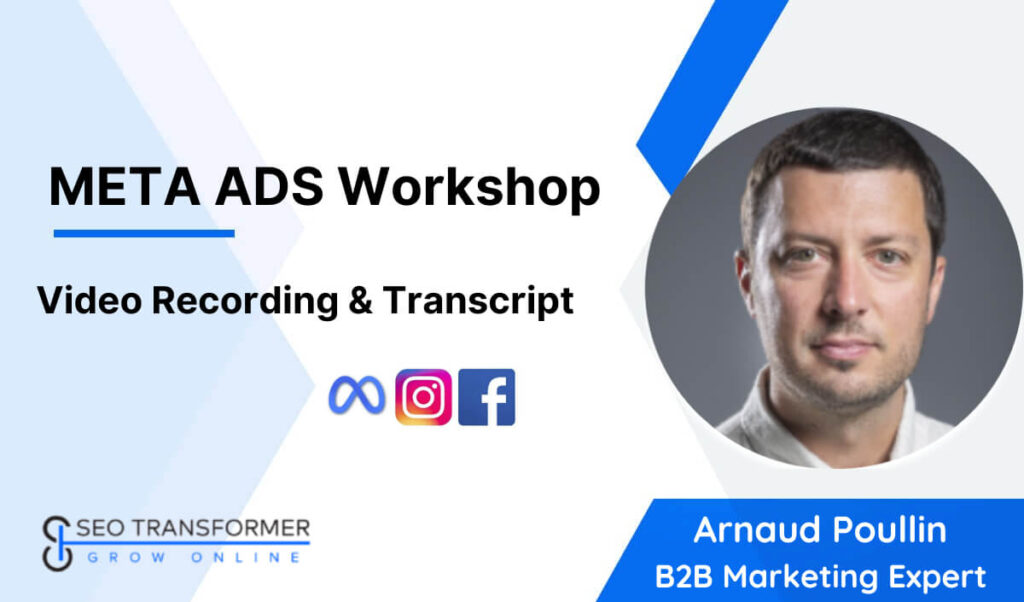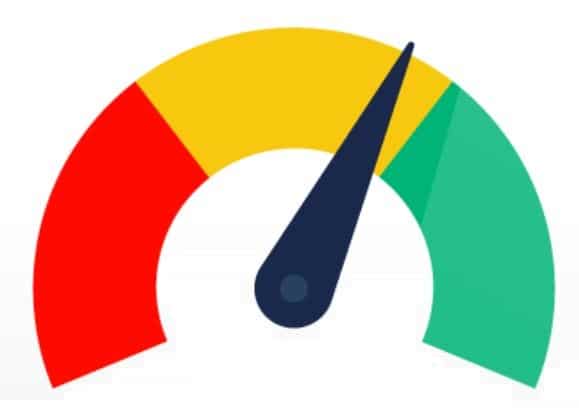Facebook & Instagram Ads Workshop Transcript
Hello everyone, and welcome to the SEO & Web Swiss Chapter. We host online community events regularly to discuss SEO, web, and social media-related topics. Stay tuned for the upcoming SEO events here.
This event is hosted by SEO Transformer, a leading digital and SEO agency serving clients in Switzerland and abroad. We have experience with international brands and multilingual sites, and we offer the integration of best practices, technologies, and digital trends to support decision-making and maximize results.
Introduction to the Guest Speaker
Today’s webinar is about Facebook and Instagram ads for the Swiss market in 2023. Our guest speaker is Arnaud Poullin, an e-commerce and B2B marketing specialist, who has been working in the digital space for 10 years as a project manager, marketing manager, and social media manager for various companies. He specializes in acquisition; meaning finding relevant, quality customers through Facebook and Instagram ads.
Introduction to the Topic
The aim of this session is to help you get a better understanding of what Instagram and Facebook ads are, how the Meta platforms work for ads, and how you can use ads in your own business.
1. How Facebook Works
What you need to understand about Facebook is that the platform is really hungry for data. That’s because data is key, no matter what you are doing, whether you are doing organic marketing like posting photos or videos, whether you are a regular person, a company or a Facebook page, or running advertisements. That’s because Facebook is powered by a machine-learning algorithm. Basically, the algorithm needs constant quality data to operate and be relevant to reach its goals. So, that’s why there are many regulations – because Facebook is trying to get data out of anything, anywhere.
If you are running an advertisement campaign on Facebook, you can feed your own data to the algorithm in order to find the right people. Let’s say you want to teach 6- or 7-year-olds how to learn to read by themselves. If you give them a postcard to read, then their learning will be very limited – but if you place them in a library without thousands of books, then they will have more material to learn from.
The same is true for the algorithm – the more data you give it, the more efficiently it works.
The machine learning algorithm can get data from anywhere – Facebook app, Messenger app, Instagram app, and maybe even WhatsApp. So there are multiple sources of data.
There are also website partners and an Audience Network. That’s millions of websites and apps where Facebook displays ads and content.
When the visitors of these websites interact with content, it allows Facebook to gather data. (Consider this similar to Google Display – when you go on the website, you see some ads.)
Let’s see how Facebook gathers ads.
Install and Configure the Facebook Pixel and Conversion API
Your website will install and configure a Facebook pixel or a conversion API pixel when you run an ad campaign on Facebook, Messenger, and Instagram. This is a sort of spy you place on your website that reports data back to Facebook. It allows the platform to know exactly what is happening on your website, who is logging into it, and who is buying stuff. This is extremely precious data for Facebook.
So, whenever a visitor clicks on your ad on Facebook and lands on your website, Facebook would know about it. When a goal is reached by a visitor, this will help Facebook find even more new visitors for you.
Verify Your Website’s Domain Name
Verifying the domain name of your website is an essential part of running Facebook ads. This makes your website appear more credible and it makes Facebook more willing to operate its ads.
Rank Events From Lowest to Highest Priority
Another significant aspect to run Facebook ads is that you need to rank your events from the lowest to the highest priority. Since Apple gave its users the ability to browse incognito, the Facebook algorithm is now working with just one eye and it needs to overcome this gap brought about by Apple users to rank events from the lowest to the highest priority.
Verify These Events Are Detected by Facebook
Before launching your campaign, you need to verify that these events have been detected by Facebook. This can be done through tools within the Business Manager or through the website and you will see live if Facebook is detecting the events.
Although these four points sound a bit technical, if you do them, the cost of acquisition for your goals will be less expensive.
Now, on to the next part…
2. Creativity is Key to Success on Facebook
Apart from gathering data, Facebook has one more obsession – it is to give its users the best experience possible. This means for every user, the platform has to present the right content, whether it is organic or paid ads.
Facebook wants its users to stay as long as possible on the app or the website and interact as much as possible because this allows Facebook to gather more data. Hence, it is more valuable for Facebook to operate with that.
The best user experience is key to understanding how Facebook operates and displays your content –whether it’s organic or paid –because competition is fierce! Facebook is running millions of ads each day.
The best ads are creative and accurately display what the target audience wants and they will be shown way more than the ones that do not have a lot of relevance to what their target audience wants. In order to stand out, you need to know that creativity is not an option, but a necessity. So you have to really think about what to say and how to say it.
Great creatives, whether it’s visuals or video, give you cheaper visits, cheaper leads, and cheaper clients. If Facebook realizes that your ad creatives are really cool and get a lot of clicks, it’s a good point for the platform because they will realize that a lot of people like your content, and the rank is going to be high, and it’s going to show your content to way more people.
The difference is quite big. For a bad-quality ad, you will be charged about 50 francs to show the ad to 1,000 people. For a good creative, the platform will charge you as little as 7 francs to show the ad to 1000 people.
Ad Formats
One thing that is vital for an ad creative and its click-through rate (CTR) is the ad format, which needs to be respected.
There are four ad formats. The most popular one on Facebook is the Square 1:1 ratio, which is used on Facebook Feed and other places like Marketplace.
The most popular one on Instagram is the Vertical 4:5 ratio ad, which is used on Insta Feed. Sometimes, Facebook Feed can also use this format.
The Vertical 9:16 ratio format is the Story format. The last one is the 16:9 format, which occupies very little screen space. As such, it does not pop out as much as the other formats. However, it is a good choice to use on Audience Network, in-stream videos, Messenger, and Instant experience.
Qualities of a Good Ad
Good ads share a few similar qualities: They have nice visuals with clear titles and an attractive descriptions. Bad ads have too much text and description on them and do not display well. An ad should also not have a CTA that says “send a Message” because chances are that the user will not get a reply unless there is someone always on Facebook ready to respond.
Before Launch Checklist
Here is a checklist you need to consider before launching your ad:
- Have I selected the right campaign objective? Your campaign objective is either leads or sales because the algorithm has been designed to find new leads and sales for you. Other interactions won’t be going to your website.
- Is my targeting too narrow? Switzerland is a small country and does not have a wide audience like in the UK, France, Germany, or even the US. However, that doesn’t mean you need to target too narrowly. For a great campaign, you need to target at least 250,0000 people.
- Is the redirection page relevant to my ad? You need to be mindful of the kind of landing page or product, or service page you redirect your audience to. Do they have the same kind of color, graphic design, or other visual identities? If not, people will get confused, and there is a high chance they will close your page, which will translate into lost opportunity and money for your business.
- Are my creatives adapted to at least two formats? We talked about the four major formats earlier so you need to be sure your ad uses the relevant format for the relevant medium or channel.
- Are my events detected? You can see your metrics for your events through Facebook’s Events Manager page.
All this won’t take you a long time, but it is important that you follow this checklist before launching your ad.
3. How to Address the Swiss Market in 2023
Let’s take a look at some tips on how to run Facebook ad campaigns in the Swiss market. These tips aren’t rocket science but they can be quite useful.
- Tell you are Swiss-based. That’s because French-speaking countries like France and Belgium can also run ads with Switzerland as a target location.
- If your product and services can be delivered anywhere in Switzerland and your website is in multiple languages, you need to target by language, not cantons.
- If your audience is located in a specific canton, like Valais or Geneva, you should mention this in your ad so that they can identify the ad is meant for them.
- If your ad is below 250,000, you should renew your creative every 7 to 10 days.
- The daily minimum budget for an ad should be about 20 francs for eight days so that you might glean some relevant insights about the offer.
- Do not raise your budget over 20%, otherwise, you may have to restart the learning process.
Don’t be afraid of Facebook campaigns. The worst that can happen is that you lose some time and money, but hopefully, you will learn some valuable lessons on the way.
4. Understand Simple KPIs to Optimize Campaigns
There are some major metrics that can help optimize your campaigns:
CPM: Cost per thousand is a metric that helps find out if a thousand people clicked on an ad, what would the cost be? During Christmas time in Switzerland, this cost can typically be about 10 to 15 francs.
CPC: The cost-per-click in Switzerland should be no more than one franc per click. With a single franc, you can get a lot of clicks but make sure one click goes no higher than one franc.
CTR: Click-through rate helps find out of the 100 people who have seen your ad, how many clicked on it. If it’s five people, then your CTR is 5%. This is a very important metric because if you are below 1%, it can be difficult for you to multiply the number of customers or prospects on your website. If you have a CTR of 5%, that is amazing.
Repetition: Generally, people need to see your ad a couple of times before they make a decision. But if you go above five or six times, then it can be too much. This means Facebook’s algorithm isn’t showing you more new ads, and maybe it is time to renew your creatives.
Cover: This refers to how many times your ad was shown to the people reached. If your ad is displayed 100,000 times and you reach 10,000 people, then your repetitions are 10, which is too much.
CPA: Cost per acquisition refers to how much it costs you if a user completes a specific action or goal. If the ratio is 1:1, then it is a bit expensive.
Bottom Line
Facebook advertising is always evolving. But once you have nailed the basics, understand how machine learning works, and why data is crucial, you can start your own campaign. You just need to practice, test, and learn until you get it right.
Make sure to be a bit rigorous on the data side to ensure that it is understood by Facebook. If you are addressing creativity and your offer fits the market you are targeting, then it is just a matter of reading the KPIs – and that’s it.
If you have questions contact the SEO Transformers.









